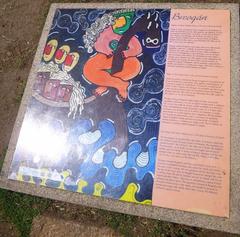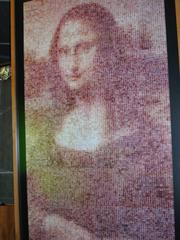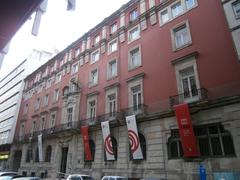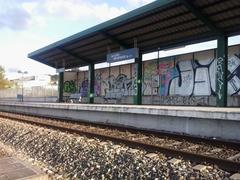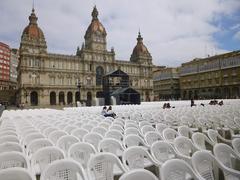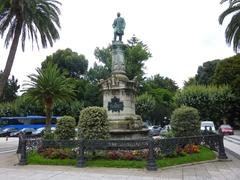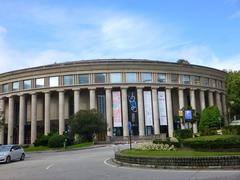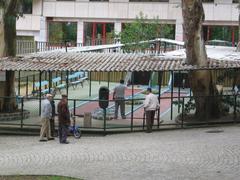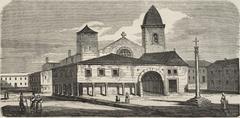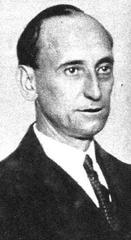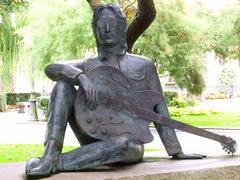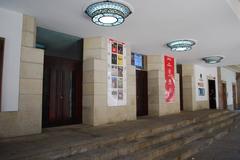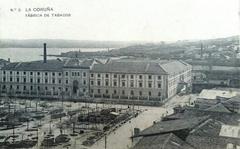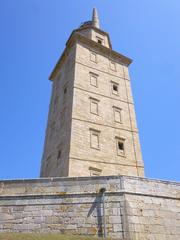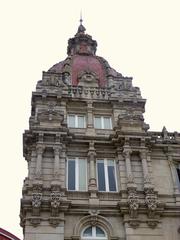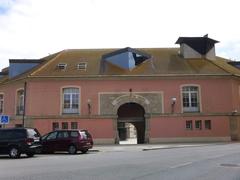
Os Cantóns Visiting Hours, Tickets, and Comprehensive Guide to A Coruña’s Historical Heart
Date: 04/07/2025
Introduction: Os Cantóns and Its Cultural Importance
Os Cantóns, located in the vibrant Galician city of A Coruña, Spain, embodies a rich tapestry of history, architecture, and civic life. Spanning the central boulevards of Cantón Grande and Cantón Pequeño, this area serves as the city’s social, commercial, and cultural nucleus. From its medieval origins and strategic port function—refounded in 1208 by King Alfonso IX—to the 19th-century emergence of its hallmark glass-enclosed galerías, Os Cantóns has continually evolved, earning A Coruña the nickname “Ciudad de Cristal” (City of Glass) (Wikipedia: History of A Coruña; Spain.info).
Os Cantóns is not only architecturally significant—with neoclassical monuments like the Obelisco de Os Cantóns and the iconic Banco Pastor building—but also socially vital. Its proximity to the Old Town, bustling port, and major commercial streets cements its role in city life, making it the stage for parades, festivals, and daily gatherings (La Voz de Galicia; Audiala Guide).
A major urban redevelopment, launched in 2025, seeks to enhance pedestrian spaces, increase greenery, and promote sustainable mobility—all while honoring the area’s historic character. This modern transformation, budgeted at €7.5–8 million, aims to reaffirm Os Cantóns’ status as a model of 21st-century urban living (El Español: Quincemil).
This guide compiles the essential details on Os Cantóns’ history, redevelopment, visiting hours, accessibility, landmarks, cultural experiences, and practical tips—ensuring every visitor can maximize their time in A Coruña’s most emblematic urban space.
Table of Contents
- The Historical Evolution of Os Cantóns
- Redevelopment 2025–2026: Vision and Impact
- Visiting Os Cantóns: Practical Information
- Landmarks and Nearby Attractions
- Visitor Experience
- FAQs and Safety
- Key Tips for a Memorable Visit
- References and Further Reading
The Historical Evolution of Os Cantóns
Medieval Beginnings and Urban Expansion
A Coruña’s development began in the medieval era as the fortified port city of Crunia. The refoundation in 1208 by Alfonso IX propelled its growth as a maritime and commercial hub (Wikipedia: History of A Coruña). Over the centuries, the city expanded from its original hilltop to the waterfront, with Os Cantóns emerging as a vital link between the Old Town (Cidade Vella) and the growing port.
19th-Century Modernization: Rise of the Galerías
The 19th century saw A Coruña’s dramatic modernization. Os Cantóns became the showcase of this change, with the construction of glass-enclosed galerías along Avenida da Marina. These balconies, designed to protect against Atlantic winds while maximizing daylight, became the city’s emblem and a symbol of its adaptation to climate and urban trends (Spain.info).
Civic and Social Role Through the Centuries
Os Cantóns quickly evolved into the preferred promenade of the local bourgeoisie and the primary stage for public demonstrations and celebrations. Its strategic location, bridging port activity and new commercial corridors, made it the heartbeat of civic and economic life (La Voz de Galicia).
20th and 21st Century Developments
The 20th century brought further modernization, with landmark buildings like Banco Pastor and expanded public gardens. Despite increased traffic and urban challenges, Os Cantóns retained its symbolic role as the city’s gateway and civic center (Wikipedia: History of A Coruña). Entering the 21st century, the area remains central to A Coruña’s urban fabric, now emphasizing pedestrian-friendly initiatives, sustainability, and heritage preservation.
Redevelopment 2025–2026: Vision and Impact
Project Scope, Timeline, and Sustainable Initiatives
The 2025–2026 redevelopment, managed by UTE Abeconsa-Canarga, spans from Calle Juana de Vega to the Port Authority and is the first step in a broader maritime façade transformation (La Voz de Galicia; Coruna365). Key objectives include:
- Unifying 9,500 m² of pedestrian zones
- Restoring Plaza de Aduanas and upgrading Plaza de Mina
- Connecting Jardines de Méndez Núñez with the Palco da Música
- Remodeling commercial corners to boost flow and business
New infrastructure will support sustainable mobility, including a segregated cycle lane and expanded BiciCoruña facilities, while enhanced lighting and urban furniture will improve comfort and safety.
Heritage Preservation and Regulatory Approvals
The redevelopment respects the area’s heritage, with oversight from Galicia’s Dirección General de Patrimonio and the city’s PEPRI commission. Historic features like the galerías and public monuments are preserved, while revitalization integrates new green spaces and improved accessibility (El Español: Quincemil).
Visiting Os Cantóns: Practical Information
Visiting Hours and Tickets
- Os Cantóns itself: Open 24/7 as a public space; no entry fee.
- Shops and Cafés: Typically open 10:00–21:00 (may vary).
- Theaters & Museums (e.g., Teatro Rosalía de Castro, Museum of Fine Arts):
- Museum: Tue–Sat 10:00–14:00 & 17:00–20:00, Sun/Holidays 10:00–14:00, closed Mon.
- Tickets for performances and exhibitions are available at venues or online.
Guided Tours and Accessibility
- Guided Tours: Local companies and tourist offices offer walking tours featuring Os Cantóns’ history and architecture.
- Accessibility: The area is pedestrian-friendly, with smooth, wide pavements, wheelchair ramps, and seating.
- Special Events: Festivals like San Juan and María Pita Festival occur annually; check event calendars for dates.
Getting There, Parking, and Transport
- Public Transport: Multiple bus lines serve Os Cantóns, with stops along Avenida da Marina and Plaza de Mina (Official city website).
- Walking: Flat terrain and wide sidewalks make it ideal for strolling.
- Parking: Underground lots at Plaza de María Pita and Avenida da Marina; parking is limited, so public transport or walking is preferred.
Landmarks and Nearby Attractions
The Obelisco de Os Cantóns
- Historical Monument: Erected in 1895 to honor Aureliano Linares Rivas, designed by Pedro Mariño, and crafted from white marble in a neoclassical style (Reisen nach Spanien).
- Civic Role: A traditional meeting point and silent witness to city events.
- Visiting Details: Outdoor, freely accessible 24/7; included in most walking tours.
Cantón Grande & Cantón Pequeño
- Urban Backbone: Parallel boulevards lined with historic buildings, cafés, boutiques, and financial institutions.
- Galerías: Iconic glass-fronted balconies define the city’s unique look (Spain.info).
Architectural Highlights and Museums
- Banco Pastor Building: One of Spain’s early skyscrapers (1925), symbolizing economic prestige.
- Jardines de Méndez Núñez: Lush city gardens with statues, fountains, and the Palco da Música.
- Nearby:
- Teatro Rosalía de Castro: 19th-century theater.
- Museum of Fine Arts: Collection of Spanish and Galician art, near Plaza de Mina.
Proximity to Old Town, Beaches, and More
Os Cantóns is a short walk from:
- Plaza de María Pita: The main city square and site of the Town Hall.
- Old Town (Ciudad Vieja): Medieval streets, Romanesque churches, tapas bars.
- Avenida da Marina: Seafront promenade with galerías and yacht clubs.
- Riazor and Orzán Beaches: Urban beaches ideal for sunbathing and swimming (Carrís Hoteles; Lonely Planet).
Visitor Experience
Atmosphere, Events, and Seasonal Considerations
- Vibrant Urban Life: Street musicians, bustling terraces, and markets create a lively scene (Viajando con Pío).
- Key Events:
- San Juan Bonfires (June 23): Bonfires and fireworks throughout the city (Spain.info).
- International Folk Festival (August): Parades and performances.
- Book and Artisan Fairs: Regularly hosted in the plazas.
Expect larger crowds and possible minor disruptions during major events and ongoing works.
Dining, Shopping, and Photo Opportunities
- Local Cuisine: Sample pulpo á feira, empanada gallega, lacón con grelos, fresh seafood, and tarta de Santiago. Pair with regional wines (Spain.info).
- Shopping: Local boutiques, artisan shops, and international brands.
- Photography: The Obelisco, galerías, and lively plazas offer excellent photo spots, especially at sunset or during festivals.
FAQs and Safety
Q: Are tickets required to visit Os Cantóns?
A: No, it is a public space. Tickets may be needed for theaters, museums, or tours.
Q: What are the best times to visit?
A: Spring to early autumn is ideal, with pleasant weather and many events.
Q: Is Os Cantóns accessible for those with reduced mobility?
A: Yes, the area is flat and currently being upgraded for even better accessibility.
Q: Are guided tours available?
A: Yes, several local operators offer historical, architectural, and gastronomic tours.
Q: How do I stay updated on redevelopment works and events?
A: Consult the official city website for current information.
Q: Is the area safe?
A: Yes, Os Cantóns is well-patrolled and considered one of the safest areas in A Coruña.
Key Tips for a Memorable Visit
- Wear comfortable walking shoes and bring a light jacket or umbrella.
- Use public transport or designated parking to avoid congestion.
- Download the Audiala app for maps, guided tours, and real-time updates.
- Try local specialties at cafés or terraces along the boulevard.
- Check event calendars for festivals or special exhibitions.
References and Further Reading
- Wikipedia: History of A Coruña
- Spain.info: Discover Os Cantóns and A Coruña
- La Voz de Galicia: Os Cantóns Redevelopment
- Coruna365: Redevelopment Project Details
- Reisen nach Spanien: Obelisco de Os Cantóns History
- Viajando con Pío: Os Cantóns Visitor Guide
- El Español: Quincemil: Urban Redevelopment and Sustainability
- Audiala Guide - A Coruña Tourism
- Official A Coruña Tourism Portal
- Xornal da Coruña: Redevelopment Updates
- Carrís Hoteles: What to See in A Coruña
- Lonely Planet: A Coruña Attractions
- Brogan Abroad: Things to Do in A Coruña
- Tourist Places Guide: A Coruña
- Nomads Travel Guide: A Coruña



